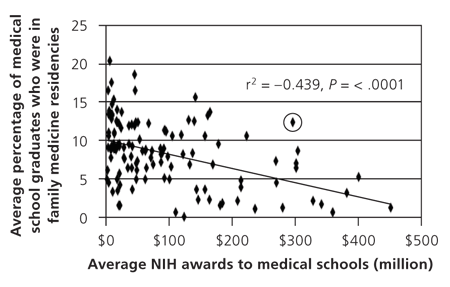
Am Fam Physician. 2013;87(3):214
National Institutes of Health (NIH) funding to family medicine departments is very low and has an inverse association with the production of family physicians at these medical schools. Clinical and Translational Science Awards and other efforts to include primary care in NIH research priorities should be considered to increase the family medicine workforce.
Despite a call for more primary care physicians to meet the demands of a growing population with multiple chronic diseases and increasing health insurance coverage, medical student interest in family medicine is steadily declining. Using NIH award amounts and the percentage of medical students entering family medicine between 2006 and 2010, we found a negative correlation between the overall NIH funding a medical school receives and the number of graduates entering family medicine (r2 = –0.439, P < .0001; see accompanying figure).1,2

This association might easily be overlooked as unrelated and almost certainly reflects the effect of other factors influencing medical students' choices.3 However, research funding has a role in determining staffing and culture at academic institutions. Between 2006 and 2010, the NIH awarded $57.6 billion in grants to universities, of which family medicine departments received less than $354 million, or about 0.4 percent.1 The amount of research funding to a family medicine department is positively associated with the size of the family medicine faculty and the number of graduates choosing to enter family medicine.4 Thus, it is possible that family medicine and research are not mutually exclusive, but that the underfunding of family medicine departments may be one explanation for the observed trend.
Can family medicine further integrate into this research culture? Only a few institutions have created rich primary care research and training enterprises with substantial NIH investment, such as the University of Washington (see accompanying figure1,2 ). Recent NIH efforts, such as the Clinical and Translational Science Awards, are opportunities to expand NIH research priorities to promote exploration of primary care and population health questions from the setting in which most patients seek care.5
